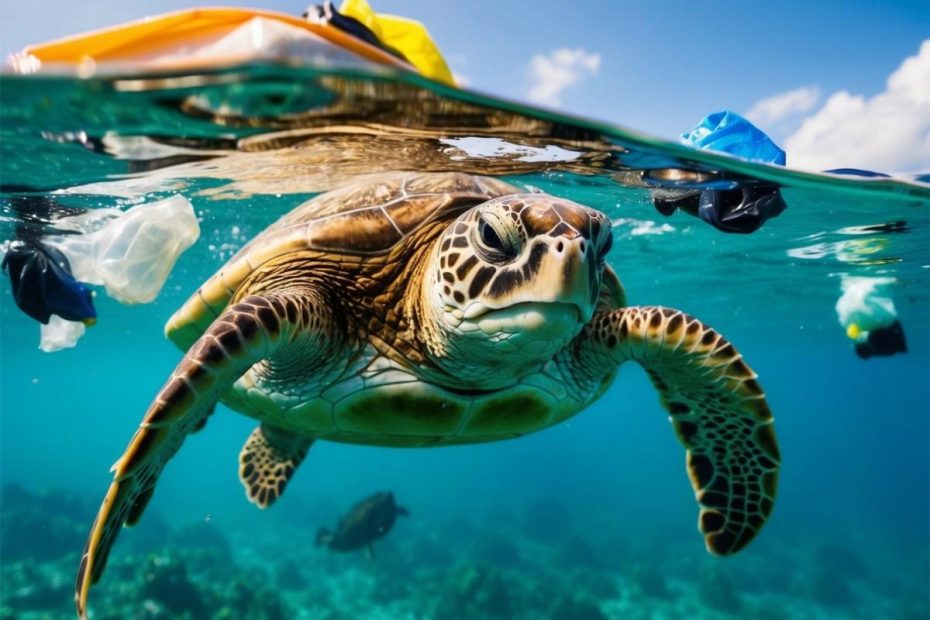Plastic pollution is a big problem for our oceans and the animals that call them home. You might not realize it, but your daily plastic use could be harming endangered species.
Breaking free from plastic can help save these animals and protect our planet.
Did you know that plastic waste enters our oceans at an alarming rate? It’s like dumping a truckload of plastic into the sea every minute! This isn’t just bad for the water – it’s terrible for the creatures living there too.
Many endangered species are at risk because of all this plastic.
You can make a difference, though! By cutting down on single-use plastics, you’re helping to keep our oceans clean and giving endangered animals a better chance at survival.
It’s like being a superhero for sea creatures – and who doesn’t want that?
Key Takeaways
- Plastic pollution harms ocean animals and puts endangered species at risk.
- Reducing single-use plastics helps protect marine life and ecosystems.
- Your everyday choices can make a big difference in saving endangered species.
The Perils of Plastic: Oceanic Impact and Endangered Species
Plastic waste is wreaking havoc on our oceans and marine life. The silent crisis unfolds beneath the waves, threatening countless species and disrupting delicate ecosystems.
Navigating the Plastic Tide

You might be shocked to learn that ocean plastic pollution could grow fourfold by 2050. This plastic tide is swamping marine habitats and harming sea creatures in ways you may not have imagined.
Picture a sea turtle mistaking a plastic bag for a jellyfish. Ouch! Or a dolphin getting tangled in discarded fishing line. Not fun at all!
Plastic waste doesn’t just look ugly on beaches. It’s a real party pooper for marine biodiversity. Fish, seabirds, and even tiny plankton are gobbling up plastic bits, thinking they’re tasty snacks.
Spoiler alert: they’re not!
Unseen Chains: Microplastics’ Massive Consequences
Hold onto your snorkels, folks! The ocean’s getting a not-so-fabulous makeover with microplastics set to increase 50 times by 2100. These tiny troublemakers are causing big problems for our fishy friends.
Microplastics are like the ninja assassins of the sea. They’re so small, you can’t see them, but they’re everywhere! They sneak into the food chain, hitching a ride in plankton, small fish, and eventually ending up on your dinner plate. Yum?
But wait, there’s more! These pesky particles can carry harmful chemicals, making them even more dangerous for marine life. It’s like a toxic takeout menu for ocean dwellers.
Ghostly Waters: How Abandoned Gear Haunts Marine Life
Ever heard of ghost gear? No, it’s not the latest Halloween costume trend. It’s abandoned fishing equipment that keeps on fishing, even when no one’s around to reel in the catch.
This spooky stuff is a real nightmare for sea creatures. Nets, lines, and traps float around like underwater booby traps, ensnaring unsuspecting animals.
It’s estimated that ghost gear kills more than 300,000 dolphins, porpoises, and small whales every year. Talk about a horror show!
But it’s not just the big guys who suffer. Fish, crustaceans, and even coral reefs can fall victim to these ghostly menaces. It’s like an all-you-can-eat buffet gone terribly wrong.
Safeguarding Our Seas: Conservation and Restoration Efforts

Our oceans face big challenges, but there’s hope! You can play a part in protecting marine life and bringing damaged ecosystems back to health.
Let’s dive into some ways we’re working to save our seas.
Breaking the Wave: Reducing Single-Use Plastic
Ready to make a splash? Your choices can help turn the tide on ocean plastic pollution.
Say goodbye to those pesky single-use items! Swap out plastic straws for reusable ones made from bamboo or stainless steel. They’re not just eco-friendly, they’re conversation starters too!
Marine protected areas are like underwater superhero hideouts. These special zones give sea creatures a safe place to thrive, away from human disturbances. By supporting MPAs, you’re giving endangered species a fighting chance.
Want to be a beach hero? Join local cleanup efforts! You’ll be amazed at how much trash you can collect in just a few hours.
Plus, you might make some new friends who share your passion for clean seas.
Reviving Our Blue Planet: Ecosystem Restoration Initiatives
Time to roll up your sleeves and get your hands wet! Ecosystem restoration is all about giving nature a helping hand.
You can join coral reef restoration projects. At these projects, you’ll plant baby corals and watch them grow into vibrant underwater cities.
Seagrass meadows are the unsung heroes of the ocean. These underwater plants are critical habitats for many species and help fight climate change.
Get involved in seagrass planting efforts and be a part of the “green” revolution beneath the waves.
Mangrove forests are nature’s coastal guardians. By participating in mangrove restoration, you’re not just planting trees – you’re creating homes for fish, protecting shorelines, and capturing carbon. It’s like being a superhero for the planet!
